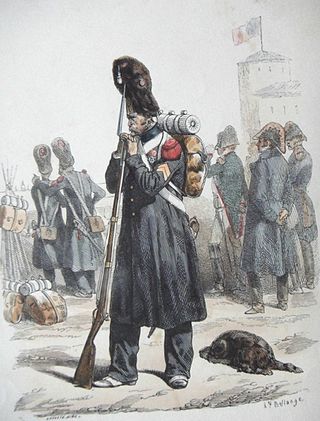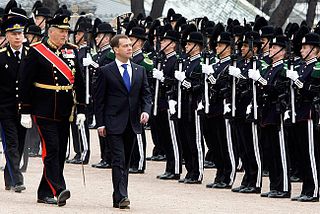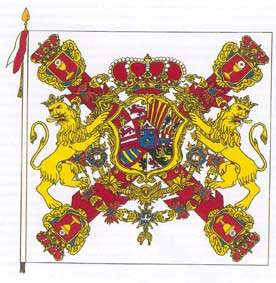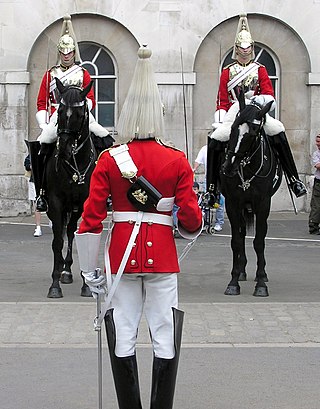
A grenadier was historically an assault-specialist soldier who threw hand grenades in siege operation battles. The distinct combat function of the grenadier was established in the mid-17th century, when grenadiers were recruited from among the strongest and largest soldiers. By the 18th century, the grenadier dedicated to throwing hand grenades had become a less necessary specialist, yet in battle, the grenadiers were the physically robust soldiers who led vanguard assaults, such as storming fortifications in the course of siege warfare.

Swiss Guards are Swiss soldiers who have served as guards at foreign European courts since the late 15th century.

The Imperial Guard was originally a group of elite soldiers of the French Army under the direct command of Napoleon I, but grew considerably over time. It acted as his bodyguard and tactical reserve, and he was careful of its use in battle. The Guard was divided into the staff, infantry, cavalry, and artillery regiments, as well as battalions of sappers and marines. The guard itself as a whole distinguished between the experienced veterans and less experienced members by being separated into three sections: the Old Guard, Middle Guard and Young Guard. The Young Guard was virtually annihilated in the Battle of Krasnoi during the French invasion of Russia.

In some militaries, foot guards are senior infantry regiments. Foot guards are commonly responsible for guarding royal families or other state leaders, and they also often perform ceremonial duties accordingly, but at the same time are combat soldiers.

An imperial guard or palace guard is a special group of troops of an empire, typically closely associated directly with the emperor or empress. Usually these troops embody a more elite status than other imperial forces, including the regular armed forces, and maintain special rights, privileges and traditions.

The Grenadiers and Rifles Guards Regiment is a regiment of the Royal Netherlands Army; along with the Garderegiment Fuseliers Prinses Irene it is one of the two Dutch Guard regiments.

The Russian Imperial Guard, officially known as the Leib Guard were military units serving as personal guards of the Emperor of Russia. Peter the Great founded the first such units in 1683, to replace the politically motivated Streltsy. The Imperial Guard subsequently increased in size and diversity to become an elite corps of all branches within the Imperial Army rather than Household troops in direct attendance on the Tsar. Numerous links were however maintained with the Imperial family and the bulk of the regiments of the Imperial Guard were stationed in and around Saint Petersburg in peacetime. The Imperial Guard was disbanded in 1917 following the Russian Revolution.

The French Guards were an elite infantry regiment of the French Royal Army. They formed a constituent part of the maison militaire du roi de France under the Ancien Régime.

The Gardes du Corps du Roi was the senior formation of the King of France's household cavalry within the maison militaire du roi de France.

The Royal Guard is an independent regiment of the Spanish Armed Forces that is dedicated to the protection of the King of Spain and members of the Spanish royal family. It currently has a strength of 1,500 troops. While the Guard participates in parades and other ceremonial events, it is a fully functional combat unit. Its members are recruited from the ranks of all three branches of the Spanish Armed Forces and receive the same combat training as regular soldiers.

The Scottish Guards was a bodyguard unit founded in 1418 by the Valois Charles VII of France, to be personal bodyguards to the French monarchy. They were assimilated into the Maison du Roi and later formed the first company of the Garde du Corps du Roi.

The Walloon Guards were an infantry corps recruited for the Spanish Army in the region now known as Belgium, mainly from Catholic Wallonia. As foreign troops without direct ties amongst the Spanish population, the Walloons were often tasked with the maintenance of public order, eventually being incorporated as a regiment of the Spanish Royal Guard.

The Constitutional Guard was a French royal guard formation which lasted a few months in 1792 as part of the Maison du Roi, being superseded by the National Guard. It existed in the period of the constitutional monarchy during the French Revolution.

The maison militaire du roi de France, in English the military household of the king of France, was the military part of the French royal household or Maison du Roi under the Ancien Régime. The term only appeared in 1671, though such a gathering of units pre-dates this. Like the rest of the royal household, the military household was under the authority of the Secretary of State for the Maison du Roi. Still, it depended on the ordinaire des guerres for its budget. Under Louis XIV, these two officers of state were given joint command of the military household.

The French Royal Army was the principal land force of the Kingdom of France. It served the Bourbon dynasty from the reign of Louis XIV in the mid-17th century to that of Charles X in the 19th, with an interlude from 1792 to 1814 and another during the Hundred Days in 1815. It was permanently dissolved following the July Revolution in 1830. The French Royal Army became a model for the new regimental system that was to be imitated throughout Europe from the mid-17th century onward. It was regarded as Europe's greatest military force for much of its existence.

The Cent-gardes Squadron, also called Cent Gardes à Cheval, was an elite cavalry squadron of the Second French Empire primarily responsible for protecting the person of the Emperor Napoleon III, as well as providing security within the Tuileries Palace. It also provided an escort for the emblems of the Imperial Guard and their award ceremony with flag and standard bearers.

A life guard is a military unit charged with protecting a high-ranking individual, such as a monarch.

The Guards of Honour were light cavalry regiments raised in the French Imperial Army during the Napoleonic Wars in 1813. Napoleon was short of cavalry following his failed invasion of Russia and the Guards were raised to remedy this. Drawn from members of the nobility most were already experienced riders, which meant that lengthy horsemanship training was not required. They were also expected to provide their own uniforms, horses and equipment which lessened the burden on the French treasury.





















